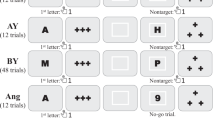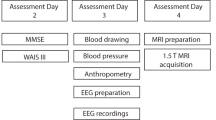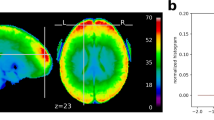Abstract
The counting Stroop is a validated Stroop task variant. Initially designed as a functional magnetic resonance imaging (fMRI) task for identifying brain regions subserving cognition and attention (dorsal anterior midcingulate cortex (daMCC) and dorsolateral prefrontal cortex (DLPFC)), it has been used to study cognition in healthy volunteers and to identify functional brain abnormalities in neuropsychiatric disorders, such as attention deficit hyperactivity disorder (ADHD). During the counting Stroop, subjects report by button-press the number of words (one to four) appearing on the screen, regardless of word meaning. Neutral-word control trials contain single semantic category common animals (e.g., 'dog' written three times), while interference trials contain number words that are incongruent with the correct response (e.g., 'two' written four times). The counting Stroop can be completed in approximately 20 min per subject and can be used offline (behavioral performance) or with fMRI, positron emission tomography, event-related potentials, magnetoencephalography or intracranial recordings.
This is a preview of subscription content, access via your institution
Access options
Subscribe to this journal
Receive 12 print issues and online access
$259.00 per year
only $21.58 per issue
Buy this article
- Purchase on Springer Link
- Instant access to full article PDF
Prices may be subject to local taxes which are calculated during checkout

Similar content being viewed by others
References
Stroop, J.R. Studies of interference in serial verbal reactions. J. Exp. Psychol. 18, 643–662 (1935).
MacLeod, C.M. Half a century of research on the Stroop effect: an integrative review. Psychol. Bull. 109, 163–203 (1991).
Bench, C.J. et al. Investigations of the functional anatomy of attention using the Stroop test. Neuropsychologia 31, 907–922 (1993).
Carter, C.S., Mintun, M. & Cohen, J.D. Interference and facilitation effects during selective attention: an H215O PET study of Stroop task performance. Neuroimage 2, 264–272 (1995).
George, M.S. et al. Regional brain activity when selecting a response despite interference: an H215O PET study of the Stroop and an emotional Stroop. Hum. Brain Mapp. 1, 194–209 (1994).
Pardo, J.V., Pardo, P.J., Janer, K.W. & Raichle, M.E. The anterior cingulate cortex mediates processing selection in the Stroop attentional conflict paradigm. Proc. Natl. Acad. Sci. USA 87, 256–259 (1990).
Bush, G. et al. The counting Stroop: an interference task specialized for functional neuroimaging–validation study with functional MRI. Hum. Brain Mapp. 6, 270–282 (1998).
Bush, G. et al. Anterior cingulate cortex dysfunction in attention-deficit/hyperactivity disorder revealed by fMRI and the counting Stroop. Biol. Psychiatry 45, 1542–1552 (1999).
Bush, G., Luu, P. & Posner, M.I. Cognitive and emotional influences in anterior cingulate cortex. Trends Cogn. Sci. 4, 215–222 (2000).
Bush, G., Shin, L.M., Holmes, J., Rosen, B.R. & Vogt, B.A. The multi-source interference task: validation study with fMRI in individual subjects. Mol. Psychiatry 8, 60–70 (2003).
Bush, G. et al. Dorsal anterior cingulate cortex: A role in reward-based decision making. Proc. Natl. Acad. Sci. USA 99, 523–528 (2002).
Bantick, S.J. et al. Imaging how attention modulates pain in humans using functional MRI. Brain 125, 310–319 (2002).
Chen, J.Y. Stroop interference is the result of comparable, not of differential processing speeds of two stimulus dimensions. Percept. Mot. Skills 87, 375–380 (1998).
Hayward, G., Goodwin, G.M. & Harmer, C.J. The role of the anterior cingulate cortex in the counting Stroop task. Exp. Brain Res. 154, 355–358 (2004).
Kemmotsu, N., Villalobos, M.E., Gaffrey, M.S., Courchesne, E. & Muller, R.A. Activity and functional connectivity of inferior frontal cortex associated with response conflict. Brain Res. Cogn. Brain Res. 24, 335–342 (2005).
Mathews, V.P. et al. Media violence exposure and frontal lobe activation measured by functional magnetic resonance imaging in aggressive and nonaggressive adolescents. J. Comput. Assist. Tomogr. 29, 287–292 (2005).
Matthews, S.C., Paulus, M.P., Simmons, A.N., Nelesen, R.A. & Dimsdale, J.E. Functional subdivisions within anterior cingulate cortex and their relationship to autonomic nervous system function. Neuroimage 22, 1151–1156 (2004).
Pavese, A. & Umilta, C. Symbolic distance between numerosity and identity modulates Stroop interference. J. Exp. Psychol. Hum. Percept. Perform. 24, 1535–1545 (1998).
West, R., Jakubek, K., Wymbs, N., Perry, M. & Moore, K. Neural correlates of conflict processing. Exp. Brain Res. 167, 38–48 (2005).
Levesque, J., Beauregard, M. & Mensour, B. Effect of neurofeedback training on the neural substrates of selective attention in children with attention-deficit/hyperactivity disorder: a functional magnetic resonance imaging study. Neurosci. Lett. 394, 216–221 (2006).
Tamm, L., Menon, V., Johnston, C.K., Hessl, D.R. & Reiss, A.L. fMRI study of cognitive interference processing in females with fragile X syndrome. J. Cogn. Neurosci. 14, 160–171 (2002).
Parry, A.M., Scott, R.B., Palace, J., Smith, S. & Matthews, P.M. Potentially adaptive functional changes in cognitive processing for patients with multiple sclerosis and their acute modulation by rivastigmine. Brain 126, 2750–2760 (2003).
Strakowski, S.M. et al. Abnormal FMRI brain activation in euthymic bipolar disorder patients during a counting Stroop interference task. Am. J. Psychiatry 162, 1697–1705 (2005).
Davis, K.D. et al. Human anterior cingulate cortex neurons encode cognitive and emotional demands. J. Neurosci. 25, 8402–8406 (2005).
Salthouse, T.A. & Meinz, E.J. Aging, inhibition, working memory, and speed. J. Gerontol. B Psychol. Sci. Soc. Sci. 50, P297–P306 (1995).
Bush, G. & Shin, L.M. The multi-source interference task: an fMRI task that reliably activates the cingulo-frontal-parietal cognitive/attention network in individual subjects. Nat. Protocols, published online 22 June 2006 (doi:10.1038/nprot.2006.48).
Whalen, P.J. et al. The emotional counting Stroop paradigm: a functional magnetic resonance imaging probe of the anterior cingulate affective division. Biol. Psychiatry 44, 1219–1228 (1998).
Whalen, P.J., Bush, G., Shin, L.M. & Rauch, S.L. The emotional counting Stroop: a task for assessing emotional interference during brain imaging. Nat. Protoc., published online 22 June 2006 (doi:10.1038/nprot.2006.45).
Oldfield, R.C. The assessment and analysis of handedness: the Edinburgh Inventory. Neuropsycholgia 9, 97–113 (1971).
Simon, J.R. & Berbaum, K. Effect of conflicting cues on information processing: the 'Stroop effect' vs. the 'Simon Effect'. Acta Psychol. (Amst.) 73, 159–170 (1990).
Burock, M.A., Buckner, R.L., Woldorff, M.G., Rosen, B.R. & Dale, A.M. Randomized event-related experimental designs allow for extremely rapid presentation rates using functional MRI. Neuroreport 9, 3735–3739 (1998).
Acknowledgements
Support for this work was provided by the Clinical Investigator Training Program of the Harvard/ MIT Division of Health Sciences and Technology-Beth Israel Deaconess Medical Center, in collaboration with Pfizer, Inc. (G.B.) and grant MH-01215 from the US National Institutes of Mental Health (S.L.R.).
Author information
Authors and Affiliations
Contributions
Initial task design was by G.B. All authors contributed to task refinement, validation testing and manuscript preparation.
Corresponding author
Ethics declarations
Competing interests
The authors declare no competing financial interests.
Rights and permissions
About this article
Cite this article
Bush, G., Whalen, P., Shin, L. et al. The counting Stroop: a cognitive interference task. Nat Protoc 1, 230–233 (2006). https://doi.org/10.1038/nprot.2006.35
Published:
Issue Date:
DOI: https://doi.org/10.1038/nprot.2006.35
This article is cited by
-
An fMRI study of scientists with a Ph.D. in physics confronted with naive ideas in science
npj Science of Learning (2021)
-
Brain activations associated with scientific reasoning: a literature review
Cognitive Processing (2019)
-
Lateral prefrontal activity as a compensatory strategy for deficits of cortical processing in Attention Deficit Hyperactivity Disorder
Scientific Reports (2017)
-
Monetary reward magnitude effects on behavior and brain function during goal-directed behavior
Brain Imaging and Behavior (2017)
-
Neural responses to a modified Stroop paradigm in patients with complex chronic musculoskeletal pain compared to matched controls: an experimental functional magnetic resonance imaging study
BMC Psychology (2016)
Comments
By submitting a comment you agree to abide by our Terms and Community Guidelines. If you find something abusive or that does not comply with our terms or guidelines please flag it as inappropriate.



